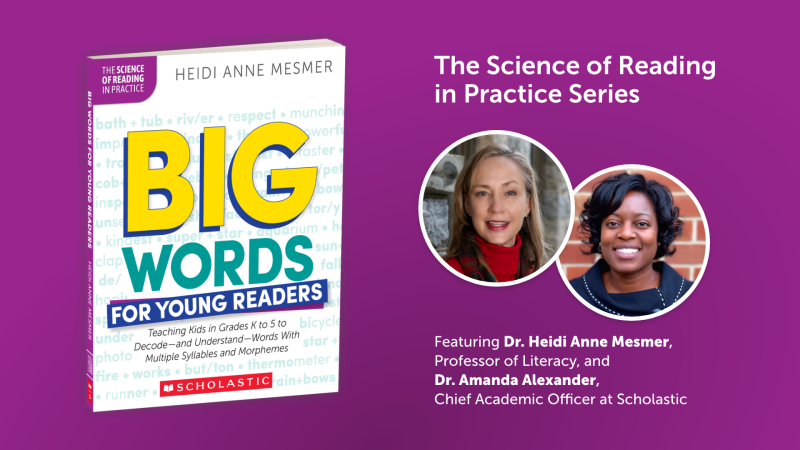Scholastic Education continues to celebrate the launch of its Literacy Framework, with the latest installment in a six-part "Science of Reading in Practice" series to provide educators best practices for implementing evidence-based strategies into their reading instruction. In the series, six literacy experts share evidenced-based strategies rooted in classroom experiences that build the foundational skills and language comprehension skills students need to become successful, confident readers.
Presented by Dr. Heidi Anne Mesmer, author of Big Words for Young Readers, and Chief Academic Officer Dr. Amanda Alexander, this fourth discussion in the “Science of Reading in Practice” webinar series emphasizes the importance of extending instruction beyond decoding short words.
In this webinar, Dr. Mesmer shares four distinct strategies for teaching words and word parts that educators can use to help their students tackle the "big" words – those with multiple syllables and/or morphemes. Along with providing a helpful K-5 scope and sequence, Dr. Mesmer also shares empowering methods for educators to enhance their phonics instruction and to help students read and understand big words with the following features:
-
Compounds, Contractions, Inflections Without Spelling Changes, Grades K–1
-
As soon as they can sound out simple words, encourage students to understand compound words with decodable compounds (e.g., sun + tan = suntan). This helps students to build confidence with big words right away. Big words should not make students freeze, and starting early helps.
-
Even in the books for kindergarteners, there are words with inflectional suffixes (e.g.,-s, -ing, -ed). Begin pointing out how these inflections add meaning to words (e.g., cats= cat (feline animal) + -s (more than 1). Focus on inflections that don’t require spelling changes, like adding the -ing to test (testing). By teaching simple inflections, students not only learn how to decode but also get their first taste of how morphemes expand the meanings of base words.
-
Engage students in word-building exercises like the "Make It Big" activity, where students expand on a base word by adding inflections and creating compound words. This exercise encourages students to experiment with word construction and can foster creativity and minimize fear when encountering unfamiliar words.
-
Syllables and Syllable Types, Grades 1–2
-
Many states address syllable types in their literacy frameworks or state standards. These are helpful in longer words that are one, single, unbound morpheme (e.g., button, hotel, elephant). Teach students to recognize types of syllables, which are sound units in the English language, to aid them in overall decoding and spelling skills. Learning six common syllable types—closed, consonant -le, open, vowel team, silent E, and r-controlled— can help students categorize and understand word patterns.
-
When students know how to recognize and can label various syllable types (e.g., closed, open, silent e) as they progress in their phonics instruction, move them onto multisyllabic words where they can apply this knowledge in more complex word structures.
-
Prefixes and Suffixes, Grades 2–4
-
In grades K-1, focus on basic inflectional suffixes without any spelling changes. From grades 2-4, introduce more complex suffixes that involve spelling changes (e.g., doubling or changing -y to -i) and derivational suffixes that alter word meaning or part of speech. Common derivational suffixes include -able, -ible, -ful, and -ly, which turn base words into adjectives or adverbs.
-
Use high-frequency roots and suffixes, or group them by meaning and incorporate activities like sorting words. Implement activities such as color-coding prefixes and suffixes, sorting multisyllabic words, and using guidance charts for inflectional suffixes.
-
Activities like word equations and sentence completion with derivational suffixes can help students understand and apply these concepts effectively.
-
Greek and Latin Word Roots, Grades 4–5
-
Teach Greek and Latin roots so that students can understand word meanings long after the early grades. Greek and Latin roots are bound morphemes that carry the core meaning in a word, but cannot stand alone. For example, in audible, "aud" relates to hearing but cannot function independently.
-
Keep in mind that multilingual learners will need additional support in understanding the big words we typically introduce in grades K-5. However, many multilingual learners also may have advantages in understanding Latin roots, especially if their first language is a Latinate tongue (e.g., Spanish, Italian). Please see the book for more research-backed activities and videos that demonstrate these activities and address the needs of multilingual learners.
Check out the full webinar here and stay tuned for more tips and strategies from our “Science of Reading in Practice” webinar series! See more of Scholastic's On-Demand Education webinars. Be sure to follow @ScholasticEdu on X for more engaging educational content.
See all of Scholastic's Phonics & Foundational Reading Skills solutions.
Watch a short video about the Scholastic Literacy Framework.
ABOUT THE AUTHOR
Heidi Anne E. Mesmer, PhD, is a Professor in Literacy in the School of Education at Virginia Tech. She has studied beginning reading materials, text difficulty, phonics, and struggling readers since 1999. Her research has appeared in Reading Research Quarterly, The Educational Researcher, Elementary School Journal, and Early Childhood Research Quarterly. She has written and directed eight grants aimed at improving reading instruction in K-5 classrooms. Dr. Mesmer is the recent author of Alphabetics for Emerging Learners, as well as Letter Lessons and First Words: Phonics Foundations that Work, Teaching Skills for Complex Text: Deepening Reading in the Classroom (Teachers College Press, 2016). She regularly consults with school districts, state departments of education, and publishers.



